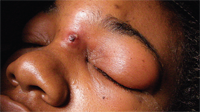 History
History
A 35-year-old black female presented following an emergency room visit for a chief complaint of pain around both eyes. She was in considerable distress, but did not report altered vision. She had no known ocular history and reported no allergies.
Diagnostic Data
Her best-uncorrected visual acuity was 20/20 O.U. at distance and near. External examination was normal, and there was no evidence of afferent pupillary defect.
The anterior segments of both eyes were normal underneath the swollen adnexa. Intraocular pressure measured 19mm Hg O.U. The dilated fundus findings were normal.
Your Diagnosis
How would you approach this case? Does this patient require any additional tests? What is your diagnosis? How would you manage this patient? What’s the likely prognosis?
Discussion
Additional tests/procedures included palpation and percussion of the area around both globes to ascertain the extent of facial swelling; the use of a Desmarres Lid Retractor to elevate both lids to complete examination of the eyes; Ludde exophthalmometry to rule out globe proptosis; and temperature measurement to rule out fever.
The diagnosis in this case is preseptal cellulitis (O.S. > O.D.) secondary to an abscess of an untreated pimple located on the bridge of the nose.
Palpable lesions, such as chalazia, hordeola, internal hordeola or insect bites, may progress toward preseptal cellulitis.1-5 In classic presentation, these lesions cause the surrounding skin to change color (red or purple), as well as yield both warmth and pain upon touch or manipulation.1-5 Malaise, fever and generalized headache are also potential symptoms.
Depending upon the location of the infection, head pain may intensify upon exertion, coughing, sneezing or postural changes, such as bending over due to irritation or stretching of the intracranial structures.1-5 Headache or head pain accompanied by signs of stiff neck, nausea, vomiting or fever suggest meningeal irritation and/or infection. Of course, headache or head pain accompanied by focal or nonfocal neurologic signs (e.g., focal weakness or numbness, aphasia, impaired cognitive function or change in personality) signal the potential for meningitis or cerebrovascular accident.5

Our patient presented with pain around both eyes. What is your diagnosis?
A diagnosis of preceptal inflammation that produces classic, acute facial pain is often not difficult to confirm.1-4 Even a prior history of hordeolum, chalazion, puncture wound or sinus inflammation––with or without respiratory allergies––may identify the flashpoint. In general, the patient will report pain of low-to-moderate intensity that increases on a daily basis over a number of days. The pain usually is localized to the frontal or maxillary area, and tenderness can be elicited upon percussion over the affected region. When the sinus is involved, the pain may be postural and likely will worsen when bending forward. Nose blowing or sneezing also may accentuate the pain.1-5
A 10-day course of broad-spectrum oral antibiotics with good tissue penetration, such as azithromycin, amoxicillin in combination with clavulanic acid, or ciprofloxacin b.i.d. to q.i.d., should improve the patient’s condition within five days. In any doubtful case, a plain film X-ray or computed tomography of the sinuses, or an opinion from an otolaryngologist, should be obtained promptly.
Topical preparations, such as bacitracin ointment in concert with hot compress––especially when external sources of drainage can be detected––also may be helpful. When cases are severe and not detected in sufficient time for oral medication use, IV antibiotics (with or without drainage) will be required.1-5
For our patient, we prescribed heat, topical bacitracin ointment t.i.d., 500mg cephalexin p.o. q.i.d. for two weeks, and an oral nonsteroidal antiinflamatory medication for pain. The patient fully recovered within three weeks.
1. Uy HS, Tuano PM. Preseptal and orbital cellulitis in a developing country. Orbit. 2007 Mar;26(1):33-7.
2. Raja V, Low C, Sastry A, et al. Pott’s puffy tumor following an insect bite. J Postgrad Med. 2007 Apr-Jun;53(2):114-6.
3. Liu IT, Kao SC, Wang AG, et al. Preseptal and orbital cellulitis: a 10-year review of hospitalized patients. J Chin Med Assoc. 2006 Sep;69(9):415-22.
4. Benton J, Karkanevatos A. Preseptal cellulitis due to Mycobacterium marinum. J Laryngol Otol. 2007 Jun;121(6):606-8.
5. Weinstein JM. Headache and facial pain. In: Yanoff M, Duker JS. Ophthalmology. Philadelphia: Mosby; 1999:11.22.1-10.

